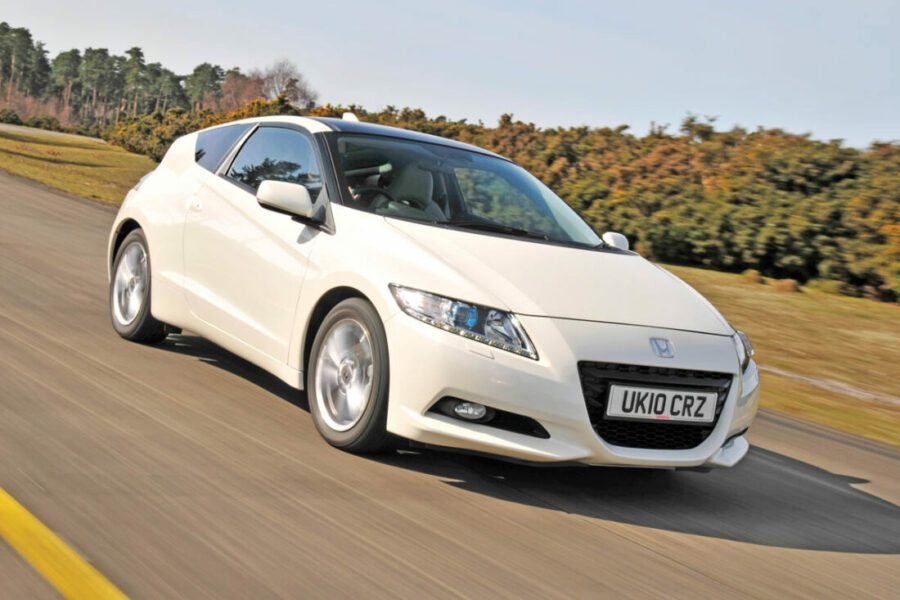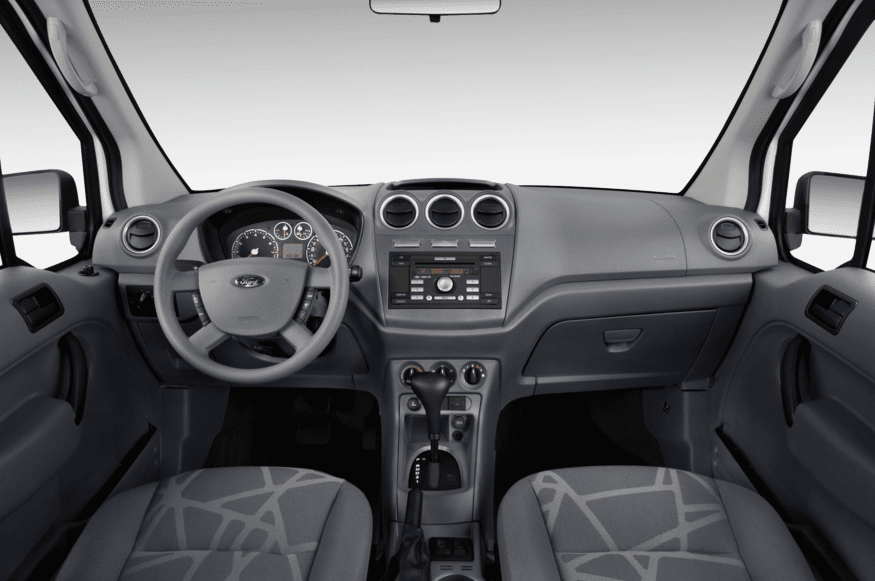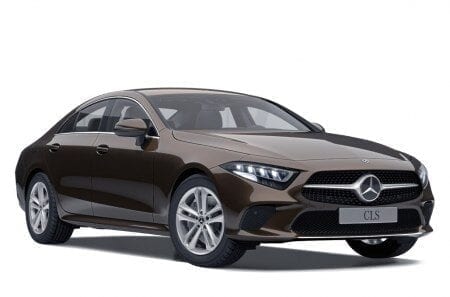
Honda CR-Z 1.5 VTEC GT
Content
Honda is supposed to be the car that gives us Europeans the impression that they still have a lot of soul in them. Built-in technology alone is never enough; the market must accept the model as its own, people must talk about it, they must be enthusiastic about it. Honda has quite a few such models, but it is probably the Civic CRX (the first generation, make no mistake) that left the deepest mark. Think of it and take a look at this CR-Z. Desirable from behind. See where I'm aiming?
Honda also makes no secret of its enthusiasm for the success of the CRX model, and with that starting point, they've also introduced the current thing: the CR-Z hybrid sports car. In a philosophical sense, he is the heir to the legendary Civic. But the CR-Z is still quite different, with the look as the design language is much more advanced from bumper to bumper, the CR-Z also doesn't have its "starter" model (in the CRX it was a Civic classic), besides the basic features, with the original the finishing of many details and its appearance evokes a strong association with built-in appliances.
To emphasize its sportiness, the CR-Z is a classic station wagon in the strictest sense of the word: it is short, wide and low, the roof is almost flat all the way down to the rear of the car, the side doors are long. , it sits sportyly low, and the interior at first glance leaves no question about where to place this car. Among modern cars, this is also the kind of coupé that uses the 2 + 2 sign to the last decimal place: although there is enough space in the front, there is only room behind the front seats for a sample.
There are two seats, two seat belts and two curtains, but if the driver is an average European, then the passenger behind him will have nowhere to put his feet, he can only keep his head at a height of about 1 meter. (Baby) There are no pillows, and all that's left for the last two passengers are beautifully designed (shell) seats. This does not even include a slightly larger child seat. In the consciousness that at the first meeting with him there will be no disappointment. The only consolation is that, as already mentioned, the CR-Z is a station wagon with a door in the rear, with a reclining rear seat and thus with the ability to carry larger luggage.
Everything is in order with the driver (as well as with the navigator), just the opposite. The seats are pleasing to the eye, with integrated head restraints, a mix of smooth and perforated leather, very good lateral grip and flawless performance even after several hours of driving. The exterior mirrors have a good image, while the interior mirrors are only extremely useful as the glass is split laterally, there is no rear wiper (which further reduces the rear view) and there are quite a few blind spots (especially for the left and back) ... But for some reason, we also see the characteristics of classic sports cars. At the same time, it means good forward visibility, ergonomic steering and a sporty driving experience.
All in all, Honda doesn't boast many major sporting successes (well, except for Senna's F1 days, but even then they just got the engine ready), but they still seem to know how to make extremely good products. Sport Car. The CR-Z has an excellent steering wheel, as does the steering gear - with exceptional wheel-to-ground feel and just the right amount of precision and responsiveness, so it still doesn't get in the way of day-to-day traffic and rides smoothly. Equally impressive is the gear lever, which is short and its movements are short and precise. There aren't many better ones on the market at the moment. Add to this the well-marked classic tachometer and the well-placed digital speedometer, and the impression of sportiness from this car is perfect.
And we are at the door. Brochures and other promotional materials will correctly show hybrid technology as the sum of the characteristics or curves of the torque and power of the gasoline and electric motors. And it is true. But - in practice, not always, or from our point of view, somewhere in half of the cases. We drive, for example, on a country road with many turns, even with a noticeable change in altitude, up and down, in short, of such variety that the speed of up to 100 kilometers is at times close to the (otherwise very high) physical limit of the mechanics of this Honda. Dynamic driving means a lot of adding and removing gas, a lot of braking, shifting gears and turning the steering wheel.
Such a ride is ideal for hybrid vehicles, and the CR-Z is a truly lively and powerful sports car with it. Because the ride allows the additional battery to be charged and discharged at a pleasant pace, electric driving assistance can be frequent and effective. Battery charge ranges from two to six-eighths (there are only eight lines on the gauges to charge the battery, hence the claim), and every time the driver goes all the way, the driver feels like someone is honestly pushing him from behind. ; this is when the auxiliary electrical equipment is turned on. Big. Then the whole theory of the sum of powers is true.
The other extreme is the highway and driving at full throttle. Here the electronics understands that the driver needs all the energy - this is not a joke, so he does not allow to charge an extra battery that is discharged after the first 500 meters of such a ride. Then you realize that you are only driving with the help of a 1-liter engine, which can still be (technically) good, but too weak for the car's weight. That's when claims to a sports car, at least in terms of performance, are not justified.
Perhaps this is even more noticeable when driving uphill, for example, in Vršić. There, on the first descent, you will use up all your electricity, and the gasoline engine sighs and cannot give the feeling of sportiness in a better mood. Even then, down, not much better. Since it is mainly braking, the auxiliary battery is charged immediately, but due to the prevailing braking, it is also useless.
Real life happens somewhere in between, and the CR-Z, as a technically advanced hybrid, offers three ways to use the drive: green, normal and sporty. There is also a significant difference behind the wheel between the two, which they achieved thanks to a noticeable difference in accelerator pedal response, although there are also differences in other devices, right down to the air conditioning. In practice, the performance is really very good, only the cruise control casts some shadow on it, which must first wait for the car's speed to drop by about five times when calling the set speed (and assuming you are driving at a similar or higher speed). current speed) kilometers below the set speed, then accelerate to the set speed.
This is incomprehensible, since it is acceleration that absorbs the most energy. And in this case it is not “eco”. Even when cruise control is on, the CR-Z accelerates very slowly, too slowly, regardless of which program is on. To drive this hybrid, like all similar ones, it is not necessary to have special prior knowledge in the field of technology, but the driver can follow the events: one of the on-board computers shows the flow of power between the additional battery, electric motor and gasoline engine. and wheels, permanent displays show the charge of the auxiliary battery and the direction of power flow of the hybrid part (i.e., whether the auxiliary battery is charged or supplies power to the electric motor for driving, both in quantity), highlighted in blue. meters, which also because of this, and especially at dusk and at night, show speed, change color: green for environmentally friendly driving, blue for normal and red for sports. A better display that is always visible and unobtrusive at the same time is difficult to imagine at this moment, although we do not claim that it does not exist.
When it comes to a hybrid, even a sporty one, fuel consumption is a hot topic. The CR-Z is exemplary from this point of view: a smooth ride to the limit without much effort and with the help of eco-mode also leads to a consumption of five liters of gasoline per 100 kilometers, on the other hand, this is not much. more than twice as much as when the gas goes to the end, which is also a commendable result. With the display of current consumption, although it is the most accurate among similar ones, we cannot help much, since this is a display from zero to ten liters per 100 kilometers in the form of a strip, but for surface orientation we can mention an Example of the difference: at 180 km / h in sixth gear (3.100 rpm), consumption in Sport mode is expected to be ten (or more) liters per 100 kilometers, and when the driver enters Eco mode, it will drop to eight liters. which means a savings of 20%.
After really careful testing under all possible conditions, our final consumption was eight liters per 100 kilometers at an average speed of 61 kilometers per hour. Big. However, in this case, any comparison with turbodiesels is inappropriate, since in practice the power reserve of this Honda is about 500 kilometers, and a thousand is no exception with turbodiesels.
And a little further to the gasoline engine. It sings beautifully, healthy and contented all the way down to the (rather rough) switch at 6.600 rpm, but from experience, you would expect the sporty Honda to be at least a thousand rpm more and about three to four decibels less noise. inside. With a modest torque, the transmission seems to be designed for a long time (in fifth gear, the engine does not turn on the chopper, but there are six gears), which slightly reduces the sportiness of this car, and the brakes give an excellent feel, except when driving slowly and carefully, you increase the effort on brakes.
We have no comments on the chassis, which provides an excellent long neutral position of the car, small lateral body vibrations and comfort when driving on at least moderately maintained roads. The criticism does not seem like an exaggeration: innovation has never been an easy task. The CR-Z featured excellent technique, including steering, but also inconveniences that you couldn't even think of behind a computer screen. And since this is not only a hybrid, but also a sports car in the full sense of the word, this combination once again confirms the idea of the name: at the moment it is something very rare. Or, to put it more bluntly: if you want a combination like this, there isn't much choice (yet).
Vinko Kernc, photo :? Aleš Pavletič
Honda CR-Z 1.5 VTEC GT
Basic data
| Sales: | AC Mobile doo |
|---|---|
| Base model price: | 28.990 € |
| Test model cost: | 32.090 € |
| Power: | 84kW (114 KM) |
| Acceleration (0-100 km / h): | 10,9 with |
| Maximum speed: | 200 km / h |
| Mixed flow ECE: | 8,0l / 100km |
| Guarantee: | 3 years or 100.000 5 km total and mobile warranty, 100.000 years or 3 12 km warranty on hybrid components, XNUMX years paint warranty, XNUMX years anti-rust warranty. |
| Oil change every | 20.000 km |
| Systematic review | 20.000 km |
Cost (up to 100.000 km or five years)
| Regular services, works, materials: | 1.314 € |
|---|---|
| Fuel: | 9.784 € |
| Tires (1) | 1.560 € |
| Compulsory insurance: | 2.625 € |
| CASCO INSURANCE (+ B, K), AO, AO + | 3.110 ( |
| Calculate the cost of auto insurance | |
| Buy up | € 26.724 0,27 (km cost: XNUMX €) |
Technical information
| engine: | 4-cylinder - 4-stroke - in-line - petrol - mounted transversely at the front - bore and stroke 73 × 89,4 mm - displacement 1.497 cm3 - compression ratio 10,4:1 - maximum power 84 kW (114 hp) ) at 6.100 rpm - average piston speed at maximum power 18,2 m / s - specific power 56,1 kW / l (76,3 hp / l) - maximum torque 145 Nm at 4.800 rpm - 2 camshafts in the head (chain) - 4 valves per cylinder. electric motor: permanent magnet synchronous motor - rated voltage 100,8 V - maximum power 10,3 kW (14 hp) at 1.500 rpm - maximum torque 78,5 Nm at 0–1.000 rpm. battery: nickel-metal hydride batteries - 5,8 Ah. |
|---|---|
| Energy transfer: | engines driven by front wheels - 6-speed manual transmission - 6J × 16 wheels - 195/55 R 16 Y tires, rolling circumference 1,87 m. |
| Capacity: | top speed 200 km/h - 0-100 km/h acceleration in 9,9 s - fuel consumption (ECE) 6,1 / 4,4 / 5,0 l / 100 km, CO2 emissions 117 g / km. |
| Transportation and suspension: | limousine - 3 doors, 4 seats - self-supporting body - front individual suspension, spring legs, triangular cross beams, stabilizer - rear multi-link axle, coil springs, stabilizer - front disc brakes (forced cooling), rear disc brakes, mechanical parking brake on the rear wheels (lever between seats) - rack and pinion steering wheel, electric power steering, 2,5 turns between extreme points. |
| Mass: | empty vehicle 1.198 kg - Permissible gross vehicle weight 1.520 kg - Permissible trailer weight with brake: n.a., without brake: n.a. - Permissible roof load: n.a. |
| External dimensions: | vehicle width 1.740 mm, front track 1.520 mm, rear track 1.500 mm, ground clearance 10,8 m. |
| Inner dimensions: | front width 1.420 mm, rear 1.230 - front seat length 520 mm, rear seat 390 - steering wheel diameter 355 mm - fuel tank 40 l. |
| Box: | Trunk volume measured using AM standard set of 5 Samsonite suitcases (total 278,5 L): 5 places: 1 backpack (20 L); 1 suitcase (68,5 l) |
Our measurements
| T = 30 ° C / p = 1.220 mbar / rel. vl. = 25% / Tires: Yokohama Advan A10 195/55 / R 16 Y / Mileage condition: 3.485 km | |
| Acceleration 0-100km: | 10,9s |
|---|---|
| 402m from the city: | 17,3 years ( 130 km / h) |
| Flexibility 50-90km / h: | 9,3 / 10,6s |
| Flexibility 80-120km / h: | 15,5 / 21,9s |
| Maximum speed: | 200km / h (WE.) |
| Minimum consumption: | 6,4l / 100km |
| Maximum consumption: | 13,0l / 100km |
| test consumption: | 8,0 l / 100km |
| Braking distance at 130 km / h: | 72,3m |
| Braking distance at 100 km / h: | 41,7m |
| AM table: | 40m |
| Noise at 50 km / h in 3rd gear | 58dB |
| Noise at 50 km / h in 4rd gear | 58dB |
| Noise at 50 km / h in 5rd gear | 56dB |
| Noise at 50 km / h in 6rd gear | 56dB |
| Noise at 90 km / h in 3rd gear | 64dB |
| Noise at 90 km / h in 4rd gear | 63dB |
| Noise at 90 km / h in 5rd gear | 62dB |
| Noise at 90 km / h in 6rd gear | 61dB |
| Noise at 130 km / h in 3rd gear | 70dB |
| Noise at 130 km / h in 4rd gear | 68dB |
| Noise at 130 km / h in 5rd gear | 66dB |
| Noise at 130 km / h in 6rd gear | 65dB |
| Idling noise: | 38dB |
| Test errors: | unmistakable |
Overall rating (308/420)
Although it is the first of its kind to be a hybrid as well, it is an exemplary example of such a combination. Excellent design, workmanship and materials, driving pleasure and tirelessness.
Exterior (14/15)
It is small, low, typical (van) coupe, but at the same time something special. Recognizable from afar.
Interior (82/140)
The overall experience (and rating) is excellent, with some ergonomics dissatisfaction and less at the rear than just the auxiliary seats.
Engine, transmission (57
/ 40)Technically modern and well-controlled drive, but weak from the moment the extra battery runs out. Another great one.
Driving performance (61
/ 95)Easy to drive, but also with big ambitions to be a good sports coupe.
Performance (19/35)
Once again: when the auxiliary battery is discharged, the CR-Z becomes a weak car.
Security (43/45)
There are no pillows in the back and the head of a slightly older child already touches the ceiling, poor rear visibility, braking just below the AM limit.
Economy
It can be very economical even at higher speeds, but the fuel tank is small and so is the range.
We praise and reproach
propulsion and control
Stopping and starting the system
movement of the gear lever
flywheel
seat, wellness, left leg support
chassis
meters
ease of use of boxes
exterior and interior appearance
dynamic driving performance
fuel consumption
Equipment
backward visibility, blind spots
unusable rear seats
pinches the center console in the right leg
feel when braking smoothly
performance on longer ascents
one of the slots on the dashboard does not close
weak gasoline engine
slightly long gearbox
Cruise control
opaque display of the on-board computer, key fobs
for short distances

